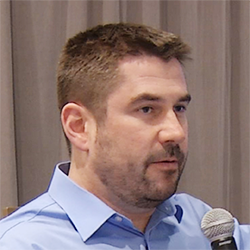Home » Managing Dysautonomias » Sorting Out Syncope & Basic Physiology with Satish R. Raj, MD, MSCI, FHRS, FRCPC
Sorting Out Syncope & Basic Physiology with Satish R. Raj, MD, MSCI, FHRS, FRCPC
Video Transcript
Mr. Al Ruechel: Hi everybody, I’m Al Ruechel and thank you for joining us again as we continue our discussions about dysautonomias and we’re specifically going to talk about syncopes and what exactly are they. Joining us right now is Doctor Raj Satish, doctor thank you for stopping by.
Dr. Satish Raj: Thank you for having me.
Mr. Ruechel: Hey, let’s talk about your qualifications a little bit, where you came from and how you’re involved in all of this stuff with autonomic problems.
Dr. Raj: Sure, so I’m trained actually as a cardiologist, specifically a heart rhythm specialist so I put in pace makers and defibrillators and things like that in my spare time. And I’m Canadian trained and I’m Canadian by birth and after I did that I actually came down to Vanderbilt University in Nashville to get some research training and I worked with Professor David Robertson down there in the autonomic disfunction center and while there, I got exposed to a variety of autonomic disorders, including those with tachycardia like POTS, I already did a fair bit of the fainting stuff, the reflex fainting that they want to discuss and then some of the orthostatic hypotension. I was supposed to go down there for just two years of training and then go back but you know Nashville was seductive and I stayed for 12 years and just moved back to Calgary about 5 years ago.
Mr. Ruechel: When we talk about syncopes, fainting basically is what that is tell me about the difference ways a person can faint and then what it’s called.
Dr. Raj: Fainting is one of those disorders that is very common and can be due to different things and some are benign, some are relatively harmless and won’t kill you in the long run but there are other causes that are life threatening.
So, one of the big challenges is to find out which. The most common forms of fainting across all ages, almost exclusively in the young but certainly as we get older it’s true as well are reflex faints and these go by a whole potpourri of names people often call them VVS or vasal vagal syncope, some people refer to them as neurocardiogenic syncope or NCS, some people refer to them as reflex syncopes and more recently I’ve colleagues referring to them as AMS or autonomic mediated syncope.
What these all have in common is that there’s a nervous system reflex that is sensing something’s wrong with the heart that then suddenly sends a signal down to either decrease the heart rate or to drop blood vessel tone but then drops blood pressure ad causes someone to not get enough blood to their brain and pass out. The nice thing, if you want to put it that way, is that this is a self-correcting mechanism because these usually occur when one is standing up, when one faints one stops standing up, one usually falls to the ground hopefully in a controlled way, blood comes back to the heart and the whole reflex reverses, often in several minutes. And then people wake up and they may feel a little tired and symptomatic for a few minutes but then are able to get on with things.
Mr. Ruechel: So, with all of these titles I think what we’re getting at in this is that this has got to be confusing the patients because some of these symptoms seem to be so similar that you wonder if there wasn’t a phrase that would describe all of them. Or does it need to be so specific that you have identified in the name what the symptoms are.
Dr. Raj: I think the issue is, I mean the most important thing for the patient is obviously have they fainted or not and then I think most of the headings you have can be put into a grab bag of a reflex faint so I don’t use the term RS but the term RS would do but this is what autonomically mediated syncope or AMS this is what neurocardiogenic syncope is trying to say this is due to a cardiovascular reflex and that’s really the most important thing and the reason that’s most important is that that eliminates other more dangerous life threatening causes of syncope.
So, the problem with syncope is that it’s an end result, it’s a fairly common symptom but the causes can be very varied going into it. And it ranges from benign, and by benign I don’t mean not bothersome or life altering but not life threatening and that’s these disorders we’re talking about, they’re not going to progress to something that will kill you but range from that to heart rhythm problems that you know you go out and if it stops and you wake up it’s called a faint because you woke up by yourself, if it doesn’t stop then you can have what’s called sudden cardiac death.
So, obviously you want to take a more aggressive posture and you may have different treatments for that group and one of the key treatments for the disorders that we’re speaking about, the reflex faints, is really to explain to the patient that they are not going to die from this, that they are not going to have a heart attack because of this, they are not going to live less long because of this regardless of what you want to call it that’s probably one of the key messages.
Visit our Education Center for Autonomic Disorders for additional video resources for patients and providers

Wolfgang Singer, MD
Associate Professor of Neurology
Mayo Clinic Rochester, MN































